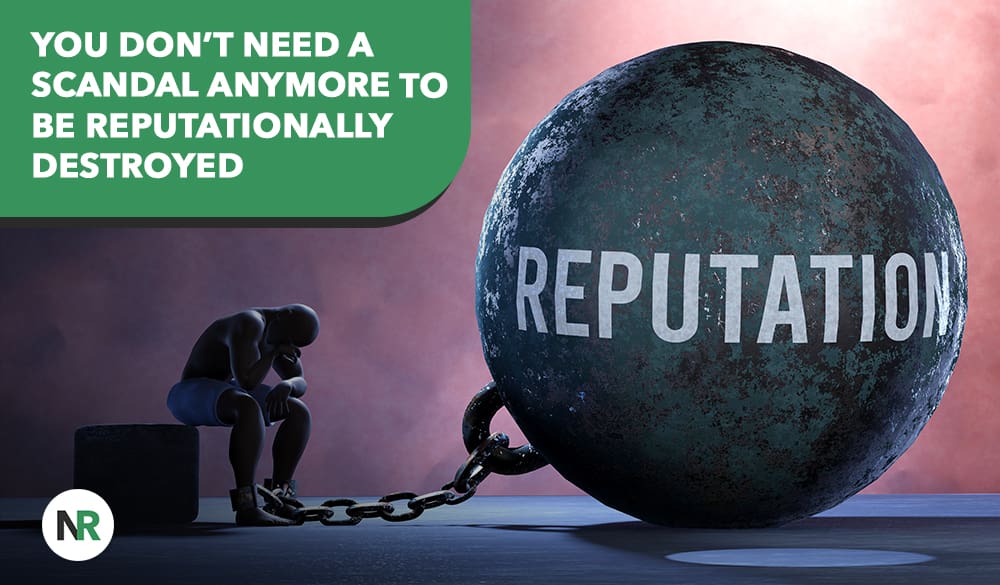In the past, it took a public scandal-a headline-grabbing event, caught on tape or exposed in court—to destroy a reputation. Today, all it takes is a tweet, a review, or a few search results to inflict severe reputational damage. We live in a world where perception shapes opportunity, and where digital permanence amplifies even the slightest mistake into a career-defining moment. You don’t need to be unethical or break the law to be reputationally destroyed—just misunderstood or poorly represented online.
Reputation Damage Without the Scandal
The erosion of public trust doesn’t always stem from a crisis. A poorly timed comment, a misunderstood post, or even outdated information published years ago can create risk. This level of reputational risk now affects everyday people, business leaders, and entire companies, not just celebrities or politicians.
This isn’t just a PR problem; it’s a serious business liability that impacts brand equity, market value, and stakeholder expectations. It’s why more organizations now turn to risk management professionals and reputation management firms to help mitigate the fallout and protect their business reputation.
Crisis Management in the Age of Google
You don’t need your own crisis management firm to understand that online visibility has a direct impact on credibility. A company’s reputation is increasingly defined by search engines, review sites, and social media, not press releases. Harvard Business Review has noted that reputation now accounts for a significant portion of a company’s market value.
Whether you’re responding to negative reviews, false claims, or outdated news articles, effective reputation management requires a structured strategy. Failing to address these issues risks long-term damage to the brand, lost revenue, and erosion of customer trust.
When Perception Outpaces Truth
One viral post, resurfaced tweet, or misinterpreted video can quickly redefine how you’re perceived, especially when search engines prioritize engagement over accuracy. In this landscape, perception often outpaces fact. Misinformation doesn’t need to be true to hurt—it just needs to trend.
And once it’s out there, even legal action or clarifications may struggle to reverse the damage. That’s why business leaders must consider reputation a key component of risk management, not an afterthought.
Get started with your free reputation evaluation today
The Cost of Online Exposure
Professionals are losing job offers based on outdated or inaccurate search results. Entrepreneurs are experiencing declines in customer trust due to negative content they can’t control. Companies like United Airlines and Wells Fargo have learned firsthand how fast a damaged reputation can impact shareholder value and profits.
In extreme cases, defamation lawsuits, public outrage, and media scrutiny follow, even when initial claims are later disproven. When your business reputation is under attack, your ability to lead, retain employees, and compete in the market suffers.
The Growing Need for Strategy
Reputation destruction isn’t just a PR risk—it’s a business continuity issue. Companies that ignore it do so at their own peril. That’s why many are establishing internal protocols or collaborating with digital specialists to protect their brand reputation proactively.
Just as you’d insure physical assets, your online presence needs protection too. A good reputation takes years to build—but it can be ruined in hours if your organization fails to act.
Why Digital Reputation Destruction Matters
The stakes are high. Reputational damage can influence elections, shareholder trust, customer loyalty, and internal morale. In today’s ecosystem, your online presence is a vital component of your business model.
From data breaches to accusations of unethical conduct, there’s no shortage of examples of how reputational harm derails even established brands. When businesses fail to take responsibility or communicate transparently, they risk losing credibility, market share, and the support of key stakeholders.
How to Protect Yourself
Reputation management is no longer optional. Whether you run a business, lead a team, or want to protect your future, here are five critical strategies:
- Monitor Your Name and Brand
Track mentions, reviews, and brand sentiment using social listening tools and alerts. Stay aware of potential issues before they escalate. - Own Your Narrative
Build and maintain a positive online presence by publishing relevant, accurate, and relatable content. Highlight your values, success stories, and community involvement. - Hire Help When Needed
Consider working with a crisis management firm or digital reputation consultant. They can help you develop a risk management plan and recover from a damaged reputation. - Respond with Strategy
If you’re facing public backlash or misinformation, respond with facts and care. Avoid knee-jerk reactions. In some cases, legal action may be appropriate. - Build a Reputation Buffer
Establish a strong foundation of goodwill with customers and stakeholders. Positive reviews, clear communication, and ethical leadership go a long way in preserving your reputation.
Final Thoughts
You don’t need a scandal to have your reputation destroyed. You don’t need a scandal to have your reputation destroyed. All it takes is the wrong story at the wrong time.
Whether it’s a poorly handled complaint, a misleading article, or a sudden surge of bad reviews, reputational risk is real—and growing. However, with awareness, self-awareness, and a commitment to taking responsibility, individuals and organizations can effectively manage these threats, restore trust, and reestablish their credibility.
Because once your reputation is hurt, the cost to recover isn’t just financial—it’s the time, trust, and opportunity you lose along the way.
